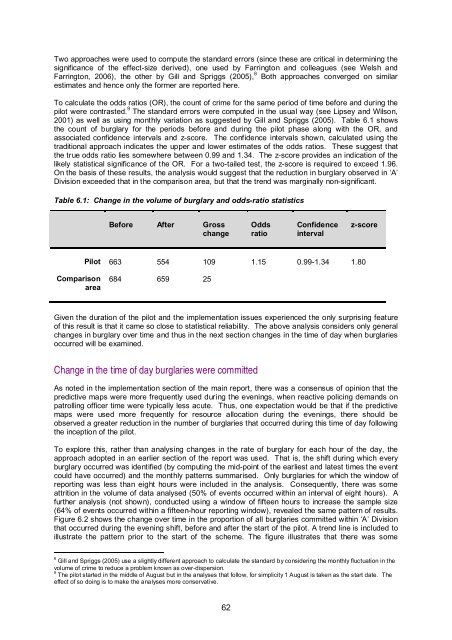Prospective crime mapping in operational context Final report
Prospective crime mapping in operational context Final report
Prospective crime mapping in operational context Final report
- No tags were found...
You also want an ePaper? Increase the reach of your titles
YUMPU automatically turns print PDFs into web optimized ePapers that Google loves.
Two approaches were used to compute the standard errors (s<strong>in</strong>ce these are critical <strong>in</strong> determ<strong>in</strong><strong>in</strong>g thesignificance of the effect-size derived), one used by Farr<strong>in</strong>gton and colleagues (see Welsh andFarr<strong>in</strong>gton, 2006), the other by Gill and Spriggs (2005), 8 Both approaches converged on similarestimates and hence only the former are <strong>report</strong>ed here.To calculate the odds ratios (OR), the count of <strong>crime</strong> for the same period of time before and dur<strong>in</strong>g thepilot were contrasted. 9 The standard errors were computed <strong>in</strong> the usual way (see Lipsey and Wilson,2001) as well as us<strong>in</strong>g monthly variation as suggested by Gill and Spriggs (2005). Table 6.1 showsthe count of burglary for the periods before and dur<strong>in</strong>g the pilot phase along with the OR, andassociated confidence <strong>in</strong>tervals and z-score. The confidence <strong>in</strong>tervals shown, calculated us<strong>in</strong>g thetraditional approach <strong>in</strong>dicates the upper and lower estimates of the odds ratios. These suggest thatthe true odds ratio lies somewhere between 0.99 and 1.34. The z-score provides an <strong>in</strong>dication of thelikely statistical significance of the OR. For a two-tailed test, the z-score is required to exceed 1.96.On the basis of these results, the analysis would suggest that the reduction <strong>in</strong> burglary observed <strong>in</strong> ‘A’Division exceeded that <strong>in</strong> the comparison area, but that the trend was marg<strong>in</strong>ally non-significant.Table 6.1: Change <strong>in</strong> the volume of burglary and odds-ratio statisticsBefore After GrosschangeOddsratioConfidence<strong>in</strong>tervalz-scorePilot 663 554 109 1.15 0.99-1.34 1.80Comparisonarea684 659 25Given the duration of the pilot and the implementation issues experienced the only surpris<strong>in</strong>g featureof this result is that it came so close to statistical reliability. The above analysis considers only generalchanges <strong>in</strong> burglary over time and thus <strong>in</strong> the next section changes <strong>in</strong> the time of day when burglariesoccurred will be exam<strong>in</strong>ed.Change <strong>in</strong> the time of day burglaries were committedAs noted <strong>in</strong> the implementation section of the ma<strong>in</strong> <strong>report</strong>, there was a consensus of op<strong>in</strong>ion that thepredictive maps were more frequently used dur<strong>in</strong>g the even<strong>in</strong>gs, when reactive polic<strong>in</strong>g demands onpatroll<strong>in</strong>g officer time were typically less acute. Thus, one expectation would be that if the predictivemaps were used more frequently for resource allocation dur<strong>in</strong>g the even<strong>in</strong>gs, there should beobserved a greater reduction <strong>in</strong> the number of burglaries that occurred dur<strong>in</strong>g this time of day follow<strong>in</strong>gthe <strong>in</strong>ception of the pilot.To explore this, rather than analys<strong>in</strong>g changes <strong>in</strong> the rate of burglary for each hour of the day, theapproach adopted <strong>in</strong> an earlier section of the <strong>report</strong> was used. That is, the shift dur<strong>in</strong>g which everyburglary occurred was identified (by comput<strong>in</strong>g the mid-po<strong>in</strong>t of the earliest and latest times the eventcould have occurred) and the monthly patterns summarised. Only burglaries for which the w<strong>in</strong>dow of<strong>report</strong><strong>in</strong>g was less than eight hours were <strong>in</strong>cluded <strong>in</strong> the analysis. Consequently, there was someattrition <strong>in</strong> the volume of data analysed (50% of events occurred with<strong>in</strong> an <strong>in</strong>terval of eight hours). Afurther analysis (not shown), conducted us<strong>in</strong>g a w<strong>in</strong>dow of fifteen hours to <strong>in</strong>crease the sample size(64% of events occurred with<strong>in</strong> a fifteen-hour <strong>report</strong><strong>in</strong>g w<strong>in</strong>dow), revealed the same pattern of results.Figure 6.2 shows the change over time <strong>in</strong> the proportion of all burglaries committed with<strong>in</strong> ‘A’ Divisionthat occurred dur<strong>in</strong>g the even<strong>in</strong>g shift, before and after the start of the pilot. A trend l<strong>in</strong>e is <strong>in</strong>cluded toillustrate the pattern prior to the start of the scheme. The figure illustrates that there was some8 Gill and Spriggs (2005) use a slightly different approach to calculate the standard by consider<strong>in</strong>g the monthly fluctuation <strong>in</strong> thevolume of <strong>crime</strong> to reduce a problem known as over-dispersion.9 The pilot started <strong>in</strong> the middle of August but <strong>in</strong> the analyses that follow, for simplicity 1 August is taken as the start date. Theeffect of so do<strong>in</strong>g is to make the analyses more conservative.62
















